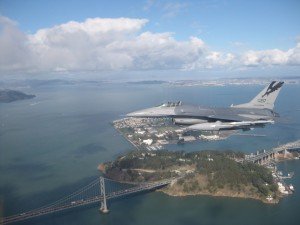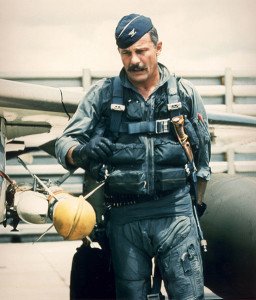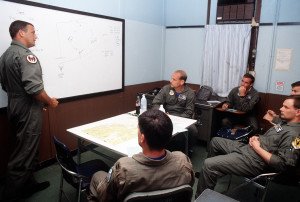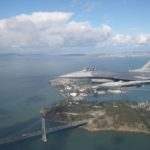 Fighter pilots fly and fight in a rapidly changing, complex environment where the margin between victory and loss is razor-thin. In a situation where people’s lives are at stake, a squadron must take every step to stay ahead of the competition. Similarly, in business, where we risk our way of life every day, the key to staying ahead of the competition and a changing environment is a culture of honest review of today’s results and innovating ahead of tomorrow’s threats. The US Air Force, Navy and Marines are built on a foundation that mandates execution of the current plan, while strongly encouraging its troops to innovate and evolve ahead of the competition. This culture of innovation keeps our armed forces at the cutting edge of performance and enables us to develop new technology and tactics to maintain our position as the superior air power in the world. The same culture of innovation can be used by businesses that are striving to innovate in their own rapidly changing environments.
Fighter pilots fly and fight in a rapidly changing, complex environment where the margin between victory and loss is razor-thin. In a situation where people’s lives are at stake, a squadron must take every step to stay ahead of the competition. Similarly, in business, where we risk our way of life every day, the key to staying ahead of the competition and a changing environment is a culture of honest review of today’s results and innovating ahead of tomorrow’s threats. The US Air Force, Navy and Marines are built on a foundation that mandates execution of the current plan, while strongly encouraging its troops to innovate and evolve ahead of the competition. This culture of innovation keeps our armed forces at the cutting edge of performance and enables us to develop new technology and tactics to maintain our position as the superior air power in the world. The same culture of innovation can be used by businesses that are striving to innovate in their own rapidly changing environments.
Because my background was flying F-4’s and F-16’s for the US Air Force, I will share my experiences primarily as they relates to this service group. There is no doubt that the USAF has developed many technologies that make piloting a modern day fighter jet easier, safer and more effective in aerial combat. Revolutionary systems such as fly-by-wire flight controls enable today’s fighter pilots to effortlessly control a dynamically unstable, 9-G capable jet in every corner of the flight envelope. Heads-up displays, also known as HUDs, allow today’s fighter pilots to fly, fight and win without ever having to bury our heads in the cockpit or go “heads down.” The innovations of radar, GPS and datalink have dramatically improved navigational accuracy, weapons delivery and overall situational awareness. Naturally, many of these innovations have made their way into commercial applications that we consumers benefit from every day. For example, technologies like Electronic Stability Control, Anti-Lock Braking, GPS Navigation, and Data Link Systems are widely used to make commercial pilots and automobile drivers safer and more effective.
Beyond the development of cutting-edge technologies, the Air Force is also a leader in innovating flight tactics. After completing training and learning standard procedure, pilots are given room to constantly experiment with new ideas. Flight leaders – regardless of seniority – are encouraged to try new tactics in training, and all fighter pilots regularly push the flight envelope of both our weapons and our jets. Senior officers state that as long as these tactics won’t “run pilots out of gas or get them killed,” a culture of innovation and new ideas are highly encouraged.

General Robin Olds, a USAF Triple Ace (16 kills in WW II and Vietnam) is considered to be one of the great fighter pilots and innovators in military aviation. His development of the tactics behind Operation Bolo, where he lured North Vietnamese Migs into a position of disadvantage by using F-4’s to simulate defenseless F-105 bombers led to seven enemy (Mig-21) kills in a single mission which dramatically impacted the North Vietnamese’s (and their Russian advisers’) operating capabilities. General Olds developed the tactics for Operation Bolo in Udon, Thailand, as Commander of the 8th Tactical Fighter Wing. Shortly after his arrival in theater, he was shocked to learn of a rash of F-4C Phantom losses at the hands of NVA Mig-21’s during a previous Operation (“Rolling Thunder”). In response, General Olds tasked four of his best and brightest junior officers to develop a plan in secret that would radically modify the predictable tactics that the USAF had been using prior to his arrival, as well as the way that radar jamming pods would be deployed. In essence, their plan was to make F-4 Phantoms appear to be F-105 bombers, from a radar perspective. Once their plan was fully baked, General Olds presented the plan to General William Momyer, Commander of the Seventh Air Force, who approved it on December 22, 1966. The Operation was executed on January 2, 1967, with devastating results to the enemy forces. Thanks to the USAF culture of innovation, General Olds felt empowered to innovate his existing technology and tactics in order to solve a major challenge for his forces. In supporting him unconditionally, General Momyer fostered this innovative culture and ensured perfect execution of the plan.
This is only one example of military innovation in the demanding environment of combat. There are many examples before this one, and many have followed since (Think Zero Dark Thirty). The questions raised are: how does the USAF create a culture of innovation, and how can you create the same culture in your business? The USAF culture of innovation is based on a foundation of hiring the best people and providing them the training they need to execute at the highest level in their jobs. I would argue that many businesses employ a similar philosophy to onboarding new personnel. In a fighter squadron we say that “once the formal training (flight school) is done, the real learning begins.” Quite simply, when you arrive fully trained to your first operational fighter squadron, you are encouraged to check your ego at the door, to keep an open mind and to start learning and innovating every day.
This is at the core of a continuous learning culture and, in the Air Force, innovation is solidly linked to a process that we call debrief. Debrief in its simplest form is real time feedback. Debrief in its most evolved form is a deep dive into the results of a mission with the sole purpose of determining what worked, what could have been done better or differently and how we will improve tomorrow. Debrief is also safe so that “what’s said in the debrief, stays in the debrief” and it’s all about learning and getting better.
After each flight, pilots conduct three different levels of debrief, each of which helps both foster new ideas and improve on the strategies and tactics already being employed.
The first level of debrief is the maintenance debrief, which occurs immediately after the pilots land and shut down their engines. When you are flying $50M fighter jets, it is essential that every piece of machinery operates flawlessly in order to maintain a technological edge over the competition. The maintenance debrief also guarantees that crew chiefs and technicians stay ahead of possible issues with machinery and electronics. For pilots, the maintenance debrief is a way to provide rapid, real-time feedback of the user experience on ever present upgrades to jets and avionics as well as confirming that previous repairs were effective.
During Operation Bolo, General Olds and his team radically innovated the way in which F-4 Phantoms were deployed. With the help of his maintenance crew, they fitted the F-4 Phantoms with the QRC-160 jamming pods normally carried only by F-105s, as a way to mimic the electronic signature of the F-105. The F-4s would also fly an inflexible line-abreast “pod formation” used by the F-105s to maximize pod effectiveness. Since the F-4 was not designed to carry these jamming pods, maintenance figured out how to mount pods on one of the fuel tank wing pylons, which forced the F-4s to carry a centerline and a single wing tank. This was a highly unusual and innovative load out for the F-4 and it created an asymmetric imbalance that made the aircraft roll on liftoff to the side carrying the wing tank. In fact, this innovation proved highly effective since the Migs bit off on the simulated helpless F-105s and were ambushed in the process. The relationship between pilots and crew chiefs is a parallel to the relationships between sales people and service reps or technicians. If these two aren’t debriefing after key sales presentations or user events, they are missing a big opportunity to innovate and win.
 After discussing maintenance concerns, pilots engage in an intelligence debrief. This is the opportunity for pilots to download to the intelligence team what they saw, how the enemy operated and what type of tactics they used. The intelligence debrief also gives the intelligence folks the opportunity to ask questions as they work to build a real-time picture of how our enemies are operating, and what innovation will be required to stay ahead of them. The relationship between pilots and intelligence troops is similar to the relationship that sales and service should have with marketing people. Downloading real-time information to the marketing team creates an innovative culture that is committed to staying one step ahead of the competition.
After discussing maintenance concerns, pilots engage in an intelligence debrief. This is the opportunity for pilots to download to the intelligence team what they saw, how the enemy operated and what type of tactics they used. The intelligence debrief also gives the intelligence folks the opportunity to ask questions as they work to build a real-time picture of how our enemies are operating, and what innovation will be required to stay ahead of them. The relationship between pilots and intelligence troops is similar to the relationship that sales and service should have with marketing people. Downloading real-time information to the marketing team creates an innovative culture that is committed to staying one step ahead of the competition.
Lastly, pilots engage in their own debrief. This is the time that the pilots who flew the mission close the door, pull the nametags off their chest and the rank off their shoulders and provide each other with honest feedback about the mission. They discuss their preparation, their tactics, and the execution of those tactics on the day’s mission. The debrief is where innovation truly occurs within the fighter squadron. Because we allow our pilots the opportunity to constantly innovate and try new tactics, the debrief is where we ask ourselves what worked, what didn’t, and what can we do better or differently next time? Because we eliminate rank in the debrief, senior officers can provide candid feedback to a junior flight lead who innovated a new tactic without fear of offending him or her. By the same token, that same junior flight leader not only can, but is highly encouraged to provide honest feedback to any other flight member regardless of rank without fear of reputational risk or career repercussions.
Through the critical concept of debrief, fighter pilots work constantly to improve their operations. We recognize that our enemies are constantly competing for air superiority, and the Air Force is committed to constantly innovating new technologies and tactics to stay ahead of the competition. By encouraging a culture of innovation, pilots are welcome to develop new technology and new tactics. This innovation leads to honest feedback and ensures that good ideas are spread and poor ones are eliminated before they expose pilots to unnecessary dangers. While not every innovation is a game changer, by constantly testing new ideas on every mission, fighter pilots accomplish the goal of innovation: to win on the battlefield and to get better, each and every day. Businesses can dramatically profit from adopting the same tools that fighter pilots use to innovate and win in the marketplace. Whether in the world of aerial combat or business combat, a culture of innovation can make your organization a winner.
